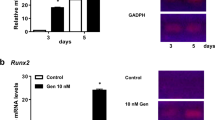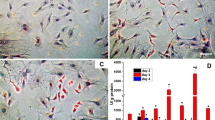Abstract
While estrogen’s role in maintaining bone health relates to its action on osteoclasts, not much is presently known about the role of estrogen with respect to osteoblasts. Our laboratory is involved in studying the function of the p53 tumor suppressor gene in osteoblast differentiation. This study was therefore designed to understand the role of estrogen in osteoblast growth and differentiation and its effect on p53 function. ROS 17/2.8 cells, stably transfected with a construct containing multiple copies of a p53 response element fused to a chloramphenicol acetyl transferase (CAT) gene, were used to monitor wild-type p53 activity. Maximal p53 activity was observed when E2 was given at concentrations between 10−12 and 10−15 M. This increase in p53 activity was due to a change in transcription and peaked at about 16 hours after treatment. An increase in p53 activity was followed by an increase in expression of p53-regulated genes p21 and mdm2. This increase in p53 activity was partially inhibited by inclusion of estrogen antagonist ICI 182,780. Bone- specific markers osteocalcin and alkaline phophatase increased after treatment with E2, as did changes in estrogen receptors α and β. Upregulation of osteocalcin was reduced when cycloheximide was added to E2, suggesting the presence of intermediates in the enhancement of osteocalcin gene transcription. These findings suggest that E2 can directly mediate an increase in p53 expression and function. The relevance of this to osteoblast differentiation is discussed.




Similar content being viewed by others
References
HM Frost (1999) ArticleTitleOn the estrogen–bone relationship and postmenopausal bone loss: A new model. J Bone Miner Res 14 1473–1477
E Romas TJ Martin (1997) ArticleTitleCytokines in the pathogenesis of osteoporosis. Osteoporos Int 7 IssueIDSuppl 3 S47–S53 Occurrence Handle9536302
M Ernst JK Heath C Schmid RE Froesch GA Rodan (1989) ArticleTitleEvidence for a direct effect of estrogen on bone cells in vitro. J Steroid Biochem 34 279–284 Occurrence Handle10.1016/0022-4731(89)90092-7 Occurrence Handle1:CAS:528:DyaK3cXhtFaitbs%3D Occurrence Handle2696848
M Ernst GA Rodan (1991) ArticleTitleEstradiol regulation of insulin-like growth factor-l expression in osteoblastic cells: evidence for transcriptional control. Mol Endocrinol 8 1081–1089
BA Scheven CA Damen NJ Hamilton HJ Verhaar SA Duursma (1992) ArticleTitleStimulatory effects of estrogen and progesterone on proliferation and differentiation of normal human osteoblast-like cells in vitro. Biochem Biophys Res Commun 186 54–60 Occurrence Handle1:CAS:528:DyaK38XltVCmsbw%3D Occurrence Handle1632789
J Bargonetti JJ Manfredi (2002) ArticleTitleMultiple roles of the tumor suppressor p53. Curr Opin Oncol 14 86–91 Occurrence Handle10.1097/00001622-200201000-00015 Occurrence Handle1:CAS:528:DC%2BD38XnsVSqsg%3D%3D Occurrence Handle11790986
N Chandar B Billig J McMaster J Novak (1992) ArticleTitleInactivation of p53 gene in human and murine osteosarcoma cells. Br J Cancer 65 208–214 Occurrence Handle1:CAS:528:DyaK38XisFeitrw%3D Occurrence Handle1739619
N Chandar P Campbell J Novak M Smith (1993) ArticleTitleDependence of induction of osteocalcin gene expression on the presence of wild-type p53 in a murine osteosarcoma cell line. Mol Carcinog 8 299–305 Occurrence Handle1:STN:280:ByuC3cjkslM%3D Occurrence Handle8280378
KA Schwartz AL Campione MK Moore N Chandar (1999) ArticleTitleP53 transactivity during osteoblast differentiation. Mol Carcinog 25 132–138 Occurrence Handle10.1002/(SICI)1098-2744(199906)25:2<132::AID-MC8>3.0.CO;2-2 Occurrence Handle1:CAS:528:DyaK1MXjs1yrsLc%3D Occurrence Handle10365915
N Chandar L Donehower N Lanciloti (2000) ArticleTitleReduction in p53 dosage diminishes differentiation capacity of osteoblasts. Anticancer Res 20 2555–2562
B Bienz R Zakut–Houri D Givol M Oren (1984) ArticleTitleAnalysis of the gene coding for the murine cellular tumour antigen p53. EMBO J 9 2179–2183
GGJM Kuiper CB Carlsson K Grandien J Haggblad E Enmark M Pelto–Huikko S Nilsson J-A Gustafsson (1997) ArticleTitleComparison of ligand binding specificity and transcript tissue distribution of estrogen receptors alpha and beta. Endocrinology 138 863–870 Occurrence Handle1:CAS:528:DyaK2sXht1OksrY%3D Occurrence Handle9048584
DJ Rickard M Subramaniam TC Spelsberg (1999) ArticleTitleMolecular mechanisms of estrogen action on the skeleton. J Cell Biochem 32/33 123–132 Occurrence Handle10.1002/(SICI)1097-4644(1999)75:32+<123::AID-JCB15>3.0.CO;2-K
Y Onoe C Miyaura H Ohta S Nozawa T Suda (1997) ArticleTitleExpression of estrogen receptor beta in rat bone. Endocrinology 138 4509–4512 Occurrence Handle1:CAS:528:DyaK2sXmsVahsbk%3D Occurrence Handle9322974
Y Furukawa (2002) ArticleTitleCell cycle control genes and hematopoietic cell differentiation. Leuk Lymphoma 43 225–231 Occurrence Handle10.1080/10428190290005973 Occurrence Handle1:CAS:528:DC%2BD38XntVartbY%3D Occurrence Handle11999551
G Liu JA Schwartz SC Brooks (2000) ArticleTitleEstrogen receptor protects p53 from deactivation by human double minute-2. Cancer Res 60 1810–1814 Occurrence Handle1:CAS:528:DC%2BD3cXisVyntbs%3D Occurrence Handle10766163
AM Molinar P Bontempo EM Schiavone V Tortora MA Verdicchio M Napolitano E Nola B Moncharmont N Medicia V Nigro I Armetta GA Abbodanza Puca (2000) ArticleTitleEstradiol induces functional inactivation of p53 by intracellular redistribution. Cancer Res 60 2594–2597 Occurrence Handle10825127
C Hurd N Khattree S Dinda P Alban VK Moudgil (1997) ArticleTitleRegulation of tumor suppressor proteins, p53 and retinoblastoma, by estrogen and antiestrogens in breast cancer cells. Oncogene 18 991–995 Occurrence Handle10.1038/sj.onc.1201233
SD Tyner S Venkatachalam J Choi S Jones N Ghebranious H Igelmann X Lu G Soron B Cooper C Brayton S Hee Park T Thompson G Karsenty A Bradley LA Donehower (2002) ArticleTitleP53 mutant mice that display early aging-associated phenotypes. Nature 415 45–53 Occurrence Handle10.1038/415045a Occurrence Handle1:CAS:528:DC%2BD38Xkt1Kgsg%3D%3D Occurrence Handle11780111
SA Kerner RA Scott JW Pike (1989) ArticleTitleSequence elements in the human osteocalcin gene confer basal activation and inducible response to hormonal vitamin D3. Proc Natl Acad Sci USA 86 4455–4459 Occurrence Handle1:CAS:528:DyaL1MXltFSjs74%3D Occurrence Handle2786632
D Ginsberg F Mechta M Yaniv M Oren (1991) ArticleTitleWild-type p53 can down-modulate the activity of various promoters. Proc Natl Acad Sci USA 88 9979–9983 Occurrence Handle1:CAS:528:DyaK38Xls1ahtg%3D%3D Occurrence Handle1946467
H Sasaki–Iwaoka K Maruyama H Endoh T Komori S Kato H Kawashima (1999) ArticleTitleA trans-acting enhancer modulates estrogen-mediated transcription of reporter genes in osteoblasts. J Bone Miner Res 14 248–255
G Liu JA Schwartz SC Brooks (1999) ArticleTitlep53 down-regulates ER-responsive genes by interfering with the binding of ER to ERE. Biochem Biophys Res Commun 264 359–364 Occurrence Handle1:CAS:528:DyaK1MXms12qs7c%3D Occurrence Handle10529369
K Pettersson F Delaunay JA Gustafsson (2000) ArticleTitleEstrogen receptor B acts as a dominant regulator of estrogen signaling. Oncogene 19 4970–4978 Occurrence Handle10.1038/sj.onc.1203828 Occurrence Handle1:CAS:528:DC%2BD3cXnslGqsbk%3D Occurrence Handle11042684
KM Coleman CL Smith (2001) ArticleTitleIntracellular signaling pathways: nongenomic actions of estrogens and ligand-independent activation of estrogen receptors. Front Biosci 6 D1379–D1391 Occurrence Handle1:CAS:528:DC%2BD3MXnsFCgur0%3D Occurrence Handle11578956
Acknowledgements
We gratefully acknowledge the kind gifts of cDNA constructs and cell lines from Drs. Vogelstein, Wozney, Oren, and Rodan, and Al Campione, Tom Naratadam, and Ann Szajkovics for technical assistance. This work was supported by funds from Midwestern University and a fellowship to SB from the Arthritis Foundation.
Author information
Authors and Affiliations
Corresponding author
Rights and permissions
About this article
Cite this article
Bovenkerk, S., Lanciloti, N. & Chandar, N. Induction of p53 Expression and Function by Estrogen in Osteoblasts . Calcif Tissue Int 73, 274–280 (2003). https://doi.org/10.1007/s00223-002-1041-6
Received:
Accepted:
Published:
Issue Date:
DOI: https://doi.org/10.1007/s00223-002-1041-6




